
 |
Eager Space | Videos by Alpha | Videos by Date | All Video Text | Support | Community | About |
|---|


NASA is planning on going back to the moon with their Artemis project, with the first landing planned for Artemis III, no earlier than 2025.
And they've chosen an architecture - a way of using different vehicles to get people to the moon and back - that is a bit different.
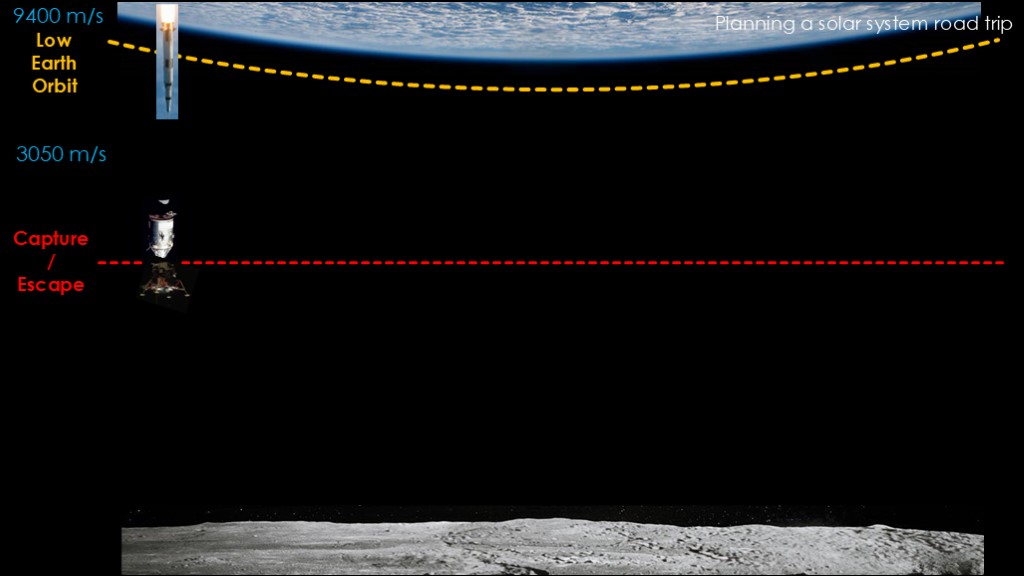
The best way to understand the Artemis architecture is to contrast it to the Apollo architecture and the short-lived constellation architecture from 2005.
I'll talking in terms of "delta v", which is the amount of energy it takes to get from one location to another in space. If you want more on delta v, see my "planning a solar system road trip" video.
The first step is low earth orbit. It takes roughly 9400 meters per second of delta v to get there from the surface.
The next step is to get to the capture escape point. From the earth it's "uphill" to the capture / escape point - it takes energy to get there. A little more than 3000 meters per second. On the Apollo missions, NASA used the mighty Saturn V to lift the command, service, and lunar modules all the way to the capture/escape point. The normal rule with spacecraft is to get the launch vehicle to do as much of the heavy lifting as possible.
The maneuver to get from earth orbit out to this point is known as "trans-lunar injection", and the amount of payload that a given rocket can send to this point is known as "TLI payload". It's considerably less than the LEO payload because the rocket needs to provide an extra 3000 meters per second of velocity. The Saturn v could lift 140 tons into low earth orbit, but it could only send about 43 tons on a trip to the moon.
Once the spacecraft hits this point, it is "downhill" to the moon - the moon's gravity will accelerate it towards the moon.

The next goal in Apollo is to get into low lunar orbit at roughly 100 kilometers above the surface. The spacecraft will need to slow down to do this, and that will take about 900 meters per second of delta-v.
A key point here is that the launch rocket can do all the work to get to the capture/escape point, but the rest of the work has to be done by the spacecraft.
The service module engine is used to slow down the spacecraft to get into lunar orbit.
And finally, the lunar module goes down and lands on the moon. It needs to use its engine to slow down to land, and that takes at least 1900 meters per second of delta v, though Apollo budgeted 2100.
Coming back is reversing the process; 1900 meters/second of delta v is required to get back to low lunar orbit. The top half of the lunar module - the ascent stage - detaches and climbs back into orbit. This approach was used because the round trip to the surface requires about 4000 meters per second of delta v and that is *really* hard to do, and using two stages makes it much easier, just as two stages makes it much easier to get to orbit from the earth's surface.
In orbit, the astronauts transfer back to the command/service module, it heads uphill to the capture / escape point, and then it's downhill back to earth.
The Apollo approach was just barely possible with 1960s technology, and NASA had to work very hard to make the spacecraft light enough to be successful.
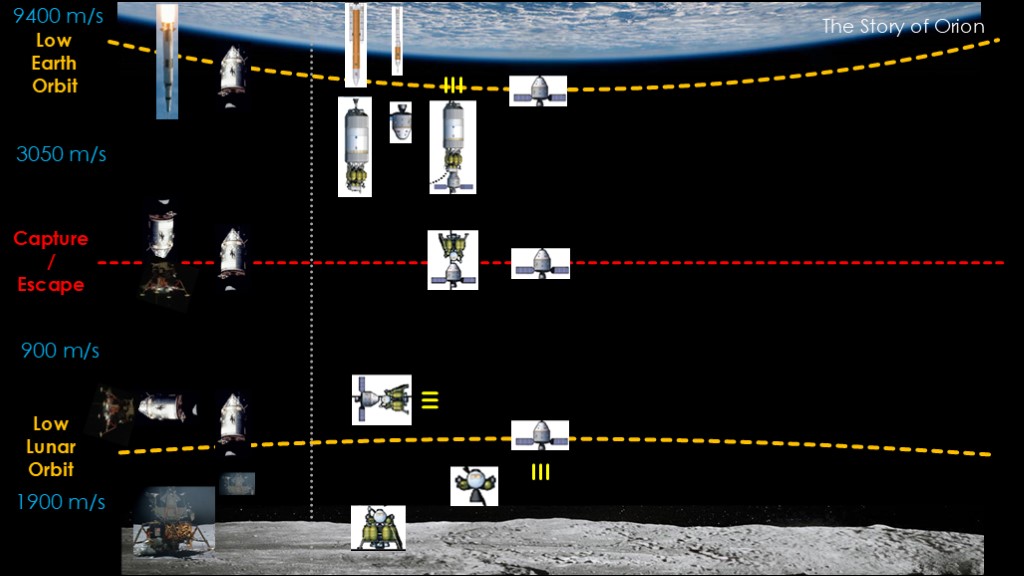
Constellation was the next architecture, developed in the early 2000s. There were different variations proposed - this is the simplest one.
An Ares V launches an earth departure stage into low earth orbit, along with a lander known as Altair on top.
An Ares I launches an Orion command and service module. They dock in orbit, and the earth departure stage provides the energy to toss the spacecraft to the capture / escape point.
The *lander* slows the stack down to get into low lunar orbit. Then - just like apollo - the lander goes down and lands, and when the exploration is done the ascent stage returns to orbit. It docks with orion, and the orion engine tosses it to the Capture/escape point and it coasts back home.
Orion only has about 1000 meters per second of delta v. It's either slowed down by the lander or - in an alternate three launch proposal - the lander and orion have individual earth departure stages that put them into low lunar orbit.
Why is the Orion command and service module so much less capable than the Apollo one? That's a bit of a long story that I cover in my video "the story of orion".
The constellation program was cancelled in 2010 and this architectural approach was abandoned.
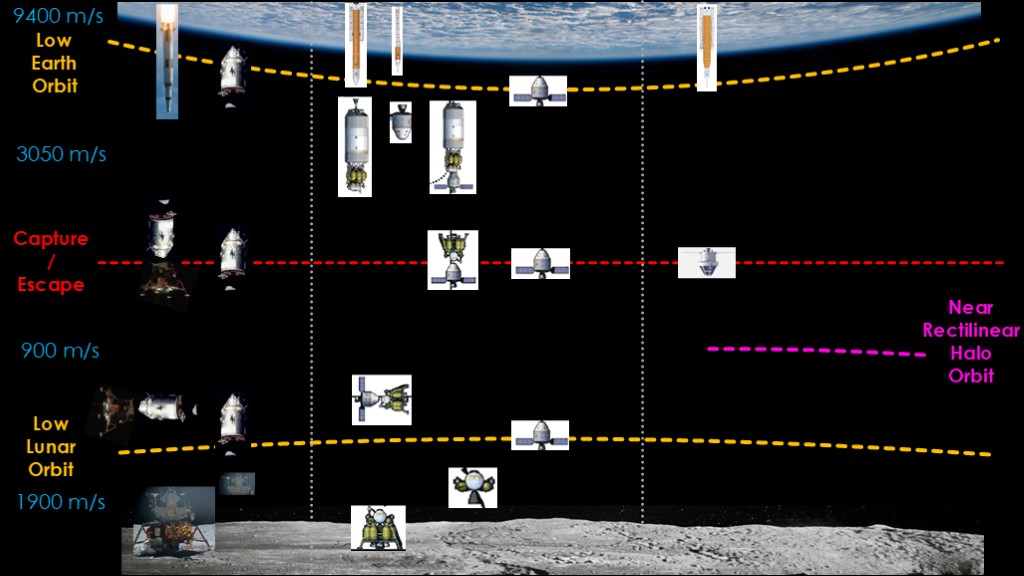
Now we move to the artemis architecture...
The SLS rocket tosses the Orion capsule and service module to the capture/escape point.
But now we have a problem. The Orion capsule was designed for constellation, and in that architecture somebody else did the work to put Orion into lunar orbit. Orion can either get into low lunar orbit or out of low lunar orbit, but it can't do both.
What we need is an alternative orbit with lower energy requirements, and NASA has chosen a Near Rectilinear Halo orbit.

When NASA first announced this choice it had everybody immediately heading to their favorite search engine, because it wasn't a commonly used orbit.
It has to do with the L1 and L2 lagrange points in the earth moon system. You might have heard about langrange points in reference to the james web space telescope, which orbits around the L2 point in the sun earth system. It's about 1.2 million kilometers farther out than the moon, so far out of this picture.
With respect to the L1 and L2 points in the earth moon system, there are four near rectilinear halo orbits - one each for each lagrange point, and one mostly north of the moon and one mostly south of the moon.
These orbits are highly elliptical; the low point is 1600 km above the moon, and the high point is 68,000 km. For earth orbits, we would call that the "Perigee" and "apogee", but because it's the moon, they would be referred to as "Perilune" and "Apilune".
NASA chose this orbit because it's a low energy orbit - much easier to get into and out of than low lunar orbit.
It's a fairly stable orbit - it doesn't take a lot of fuel to stay in this orbit.
It has a great view of the south pole, which means you can use a spacecraft in this orbit as a radio relay between the south pole and the earth.
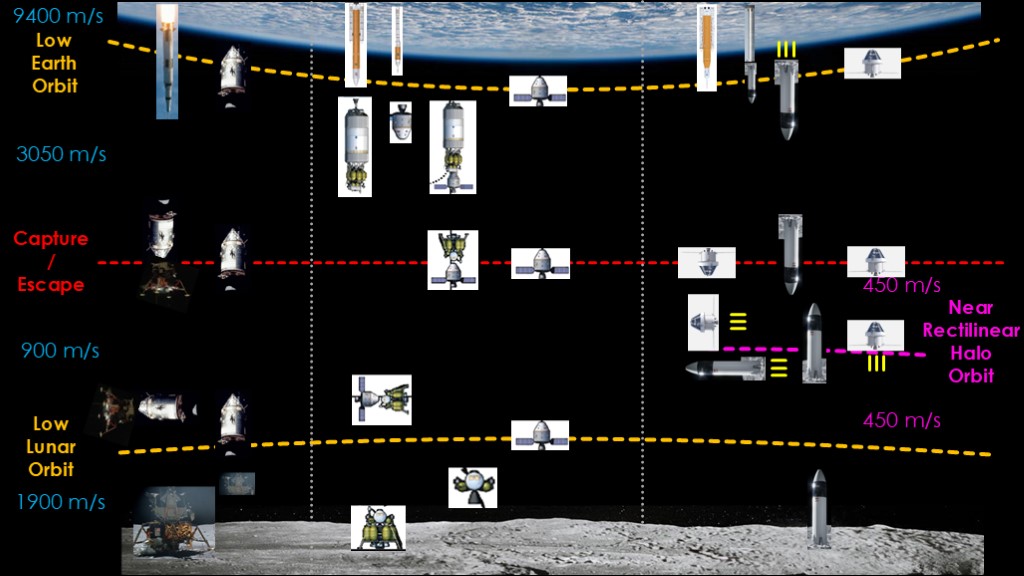
In terms of delta-v, the near rectilinear halo orbit NASA chose is roughly halfway to low lunar orbit, and the orion can get into and out of that orbit. Problem solved!
Now we need a lander. The first Artemis flights to land on the moon will use a lunar version of SpaceX's Starship. It will be launched into orbit, refueled in orbit, and then journey out to the capture / escape point, and brake itself into the same orbit as orion.
Two of the astronauts on Orion will transfer to starship, and land on the moon. When they are done, starship returns to the NRHO orbit, the astronauts go back to orion, and orion tosses them back to the capture escape point and then they coast home.
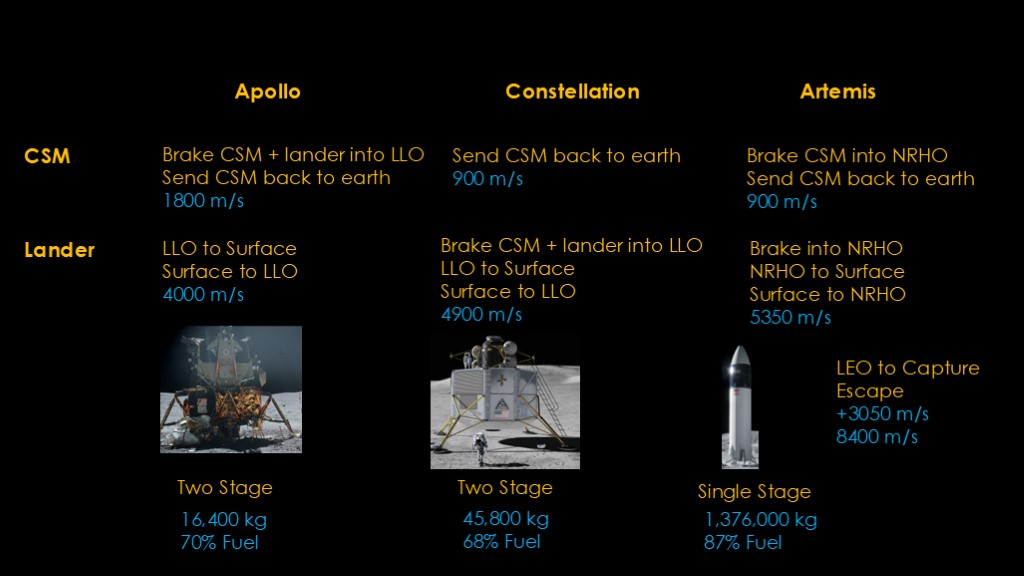
These three approaches place very different demands on their vehicles.
For apollo, the command service module will brake the module plus the lander into low lunar orbit, and then send the command service module back to earth after the lunar excursion. It needs a delta v of 1800 meters per second. The lander goes from low lunar orbit to the surface and back, and needs about 4000 meters per second of delta v.
The lunar lander is a two stage vehicle that masses 16,400 kilograms and about 70% of that mass is fuel.
For constellation, the CSM only needs to send itself back to earth, for only 900 meters per second of delta V. In this version, the delta v to get into low earth orbit comes from the lander, and adding that to the delta v to get to the surface and back bumps the total requirement up to 4900 meters per second.
The altair lander was a two stage design massing 45,800 kg, and was 68% fuel.
For artemis, the CSM needs to brake into the near rectilinear halo orbit and send itself back to earth, for a total delta v of about 900 meters per second.
The HLS lander has a difficult job; it needs to brake into NRHO and then go to the surface and back. That's about 5350 meters per second. Starship is a monster single-stage design, with a mass of 1,376,000 kg, and 87% of it is fuel. And it needs all of it, because it also needs to get from low earth orbit to the capture/escape point, which takes another 3050 meters per second bringing the total to 8400 meters per second.
Even if you build a lander that doesn't need to get to the capture escape point by itself, the 5350 meters per second requirement for the lander makes it really challenging to design. The "national team" led by blue origin proposed a three stage design to get the performance they needed; one to get to capture escape and then a two stage landing vehicle. It was a little like the earth departure stage approach used with constellation.
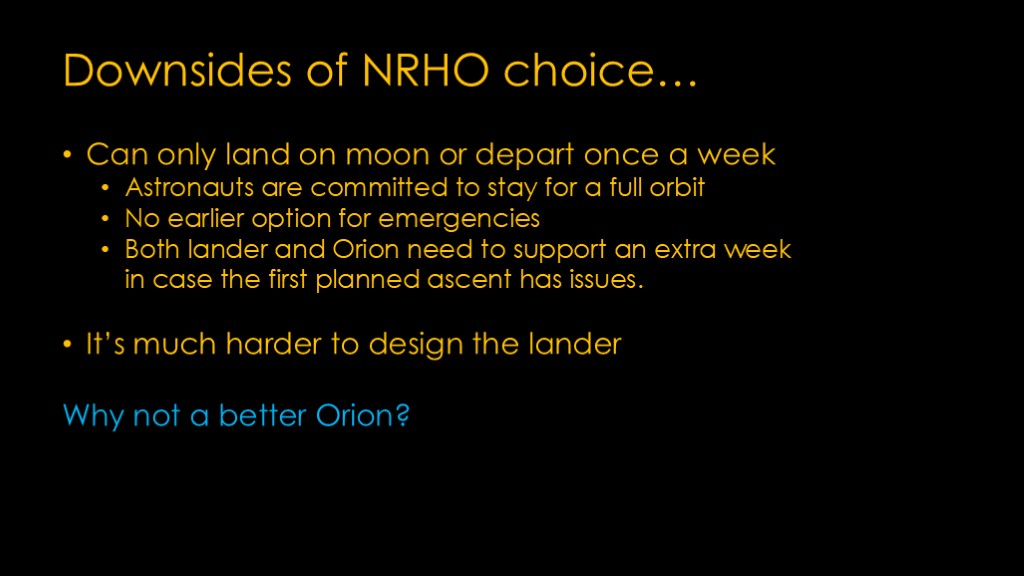
There are a number of downsides to the choice of the near rectilinear halo orbit.
The elliptical orbit limits the landing and departure times to about once a week.
The astronauts are committed to stay for a full orbit, with no earlier options for emergencies.
Both the lander and Orion need to support an extra week in case they cannot hit the first ascent window.
It's also much harder to design the lander, and therefore the lander is very expensive.
Why not build a more capable Orion?
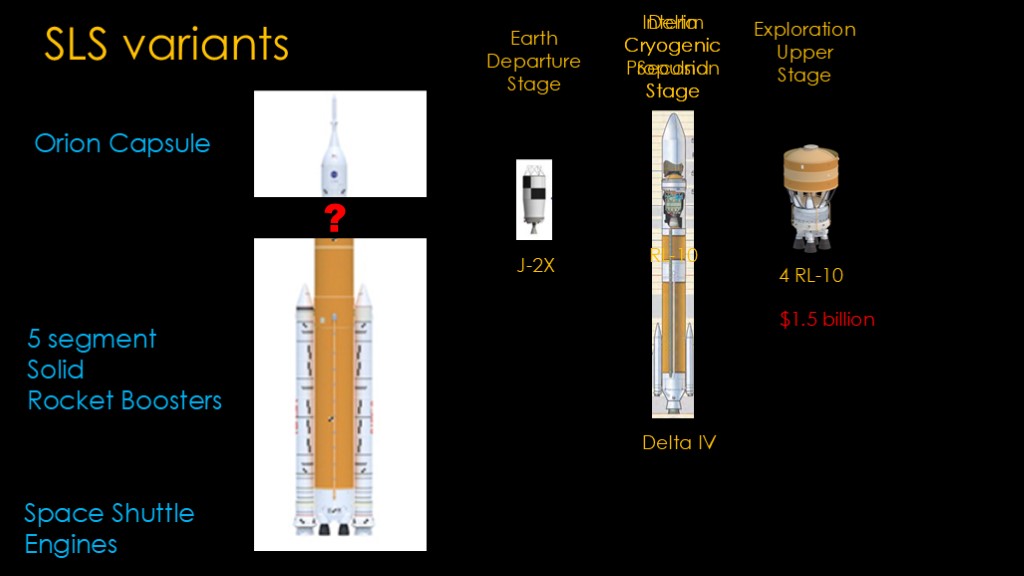
Answering that question requires a bit of a digression...
In the 2010 legislation that directed NASA to build SLS - and keep working on Orion - congress gave NASA a goal of flying SLS by the end of 2016. NASA had the solid rocket boosters, it had the engines for the core stage, and it had the orion capsule.
What it needed was a second stage...
NASA really wanted the earth departure stage from the Constellation architecture, but it unfortunately used two J-2X engines, which were not fully developed. NASA feared that the development would take too long and push SLS beyond the 2016 goal. The earth departure stage was out...
The quickest way to get a second stage was to use one that already existed. NASA looked at existing upper stages, including the one used on the Delta IV.
The delta second stage is cleverly called the "delta cryogenic second stage". NASA decided to adopt that stage so that they could meet their goal, renaming it the "interim cryogenic propulsion stage". I have no idea why they decided they needed the work "propulsion" in the name, but they did.
The delta cryogenic second stage is a fine stage but is grossly undersized for a rocket as big as SLS; the tanks are too small and it only uses a single RL-10 engine so it is low in thrust. But it allowed NASA to say they had a solution that would meet the deadline.
NASA still wanted a bigger stage, and they ultimately designed what is now called the "Exploration Upper Stage" and looks pretty much like a upsized version of the delta second stage, with bigger tanks and 4 RL-10 engines. NASA has so far spent $1.5 billion on this stage.
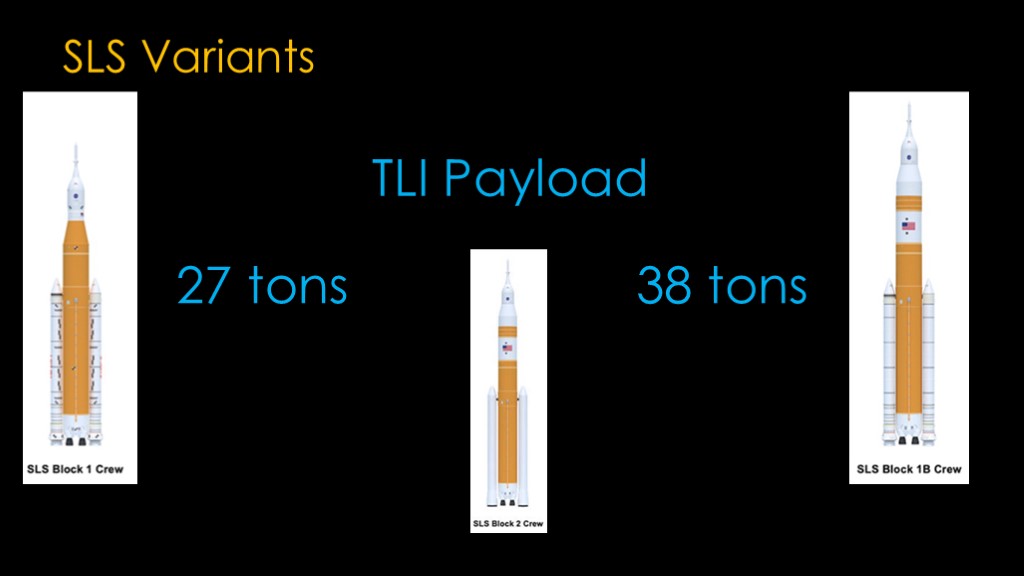
Two different upper stages gives us two SLS versions.
The block 1 uses the delta cryogenic second stage - sorry, the interim cryogenic propulsion stage - and has a TLI payload of 27 tons.
The block 1B uses the exploration upper stage, and has a TLI payload of 38 tons. As I said, the delta cryogenic stage was very undersized.
There is also - perhaps - a block 2 at some undetermined time in the future.
Artemis 1 through 3 will launch on SLS block 1, and therefore have a TLI payload of 27 tons.
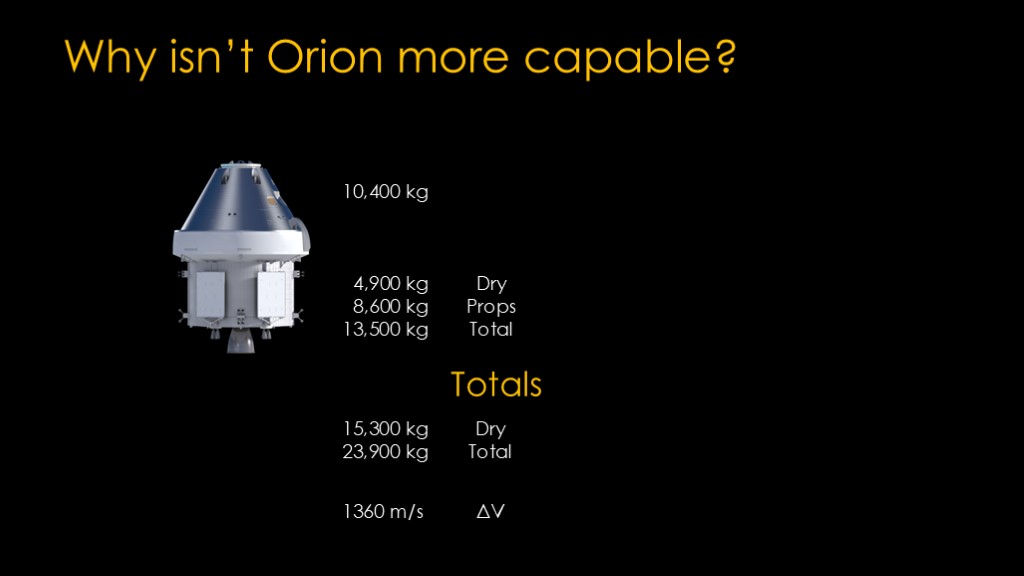
Our launcher can only do 27 tons to the moon.
The orion command module masses a little more than 10 tons. The service module is 4,000 kg dry and carries 8,000 kg propellant, so its total mass is a little more than 13000 kg. The total mass of both is 15,300 kilograms dry, 23,900 fueled, so close to the 27 ton limit. Orion could be a *little* heavier, but even if they just added propellant, it wouldn't be enough to use a low lunar orbit architecture.
NASA is therefore stuck with the NRHO; SLS block 1 simply cannot toss a spacecraft based on Orion that carries enough propellant to do low lunar orbit.
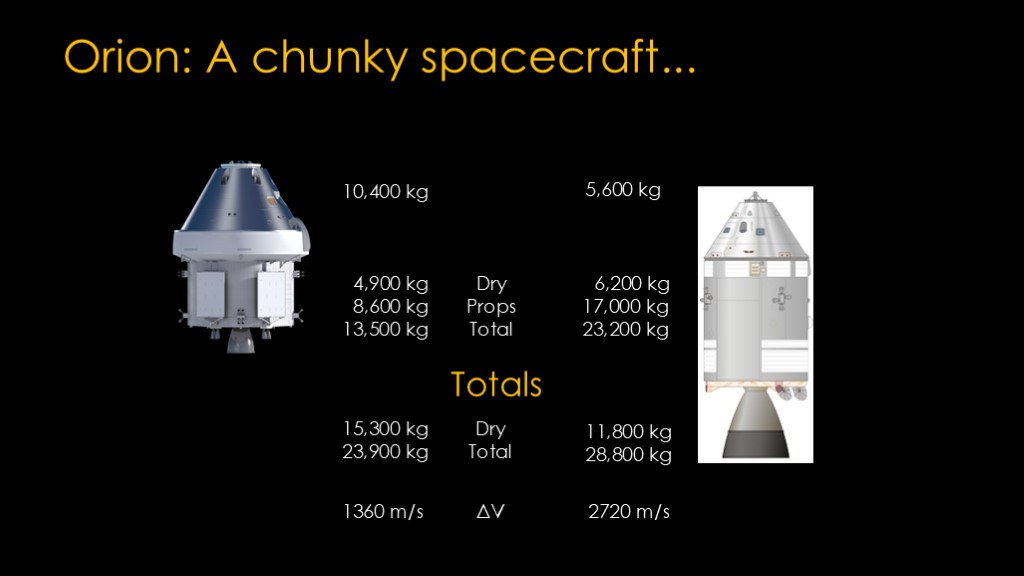
Of course I want to compare Orion to Apollo in more detail.
The Apollo command module is 5600 kg to orion's 10,400 kg, or only about 54% of the mass. It's true that Orion carries 4 astronauts to Apollo's 3 and is designed for longer duration missions, but given that materials like carbon fiber didn't exist for Apollo, nor did advanced electronics, it's disappointing that Orion has such a high mass.
The Apollo service module is much heavier than Orion's but it packs in double the propellant of the Orion service module. Overall, it has a delta v of 2720 meters/second, or twice as much as Orion.
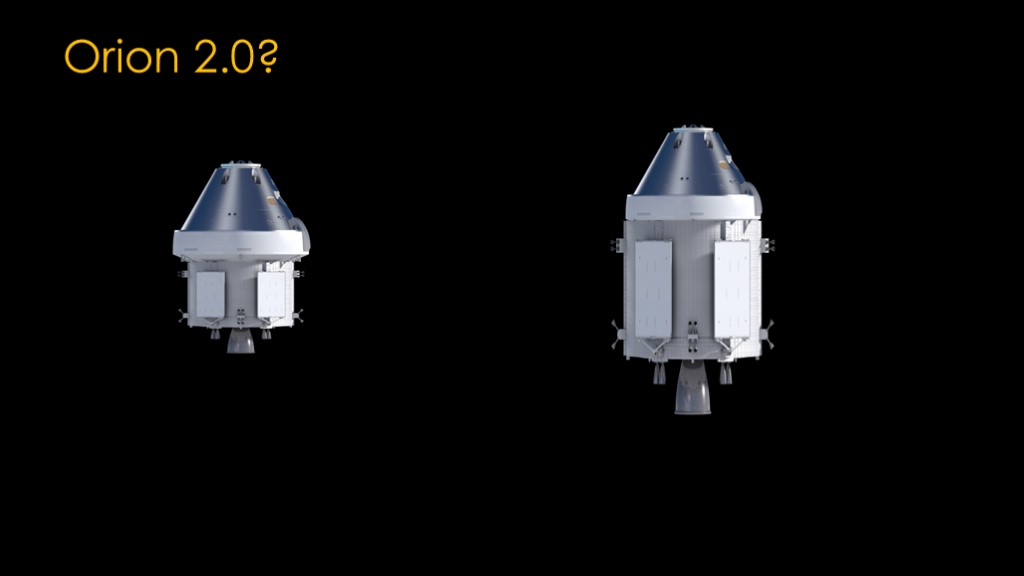
Could NASA do an Orion 2.0?
Upsize the service module to the same diameter as Orion and stretch it a bit, and you can very likely find enough delta-v to switch Artemis over to a low lunar orbit architecture.
Will we see this? No, because of a single word.

That word is "gateway", or more specifically, "lunar gateway".
But that is a topic for a future video....

If you enjoyed this video, please write a 1-act play based on the mythology of Orion the Hunter